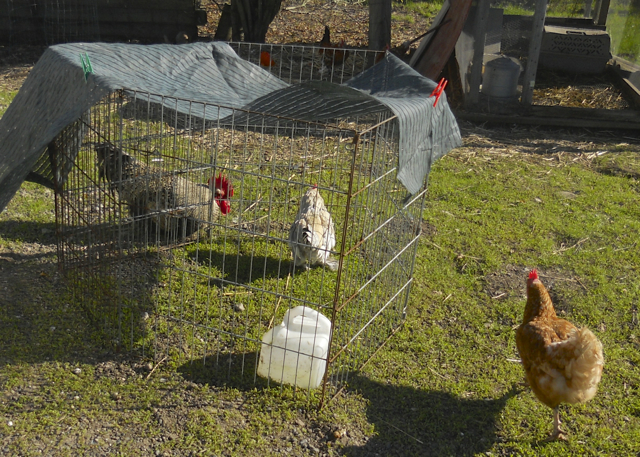
Sam is my 10 year old rescue rooster who has been blind for the last 3 years.
Blindness can be the beginning of a new life. Sam was adopted from the local Humane Society along with his brother, Isan in 2006. Isan began developing visual problems early and went blind in 2011. Both boys had several vet visits including to an eye specialist (who generously donated her time!) Cataracts were ruled out along with other various ailments. After blood work showed that they had a genetic condition which compromised their immune systems the condition was blamed on an infection caused possibly by a virus. Isan eventually developed respiratory problems and passed away in 2014.
Sam had once held the top position in the chicken yard hierarchy. Once his eyesight was gone he was no longer respected by the other birds and he was unable to protect himself. Chickens are considered prey animals and generally hide any ailments as a survival strategy. Eyesight is essential for chickens to stay safe, find food and water and to socialize. Sam had lost this ability, so like his brother before him I made the decision to have him become a House Chicken. Since then Sam has thrived indoors and even his vet is amazed at his longevity. Here are a few suggestions should you find yourself in a similar situation with your bird:
#1) Create a Space. I purchased a pet carrier that was roomy enough for Sam to move freely, stretch and crow but small enough that he would feel secure and able to find his food and water easily. The dishes snap onto the door of the carrier so I was able to adjust the height to fit his needs. The trays also cannot be knocked over and he knows exactly where to find them. Straw is used as bedding and is changed daily. I had considered the option of “chicken pants” which many people use successfully for indoor birds but decided against them as a safety issue. Wandering about the house blindly could be hazardous for Sam.
#2) Create a Routine. All creatures (including us humans) feel secure with a predictable routine which indicates normalcy and security. With Sam I try to create a certain rhythm so things happen at the same time of day. Whether it is feeding him or taking him out for a stretch, his internal clock can depend on these events. Routine can become boring even for chickens so I try to add some surprises into his day to keep things interesting such as including a new ingredient in his food tray or giving him a bath (he loves the blow-drying part).
#3) Provide Healthy Food. I have put Sam on a healthy diet to which I credit his robustness. One third of his food is commercial poultry pellets with a sprinkling of Poultry Conditioner (which is high in vitamins). I add a layer of raw sunflower seeds (good source of protein, calcium, iron and fiber). On top of that I put his greens cut into beak-size pieces (kale, parsley, broccoli and sometimes brussels sprouts, cucumber and cabbage). I also add a few dry cranberries, blueberries (antioxidants) and apple then sprinkle with sesame or flax seeds (omega-3s). This is pretty much how I eat (vegetarian, sans the Poultry Chow of course!) and setting aside a small portion for him is no big deal. Luckily Sam has a great appetite and always cleans his plate!
#4) Give Touch Therapy. All beings thrive with love and attention. Sam’s blindness has also decreased his physical mobility so massaging him around his wing and leg joints helps to stimulate blood flow to the muscles. He especially enjoys belly rubs! Petting and holding your blind bird is another way of reassuring them that all is safe and secure.
#5) Allow Fresh Air & Sunshine. Sam’s indoor carrier is next to a window where he continues get fresh air and sunlight. It allows him to hear and vocally connect with the other chickens (he still competes in crowing contests with his rooster buddies). I also have a small outdoor enclosure for Sam and in nice weather put him out when I am at home to keep an eye on him. This enables him to socialize with the resident flock without the risk of any of them hurting him. An easy outdoor enclosure can be created with portable pet fencing and aviary netting or tarp clipped over the top (shown below).
The main point is that blindness doesn’t have to mean the end of quality of life for your bird. As with any disability adjustments can be made to provide continued enjoyment of life for all involved!

Portable pet fencing provides an easy way for Sam to socialize in a safe environment.
-Singing Luna 3/7/2016
Seed for thought: With proper care chickens can live from 15-20 years!













